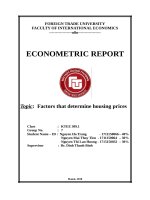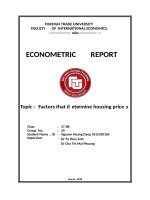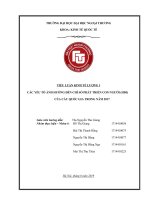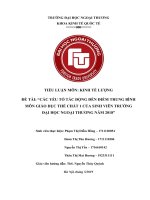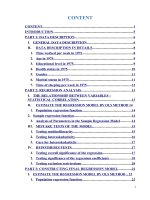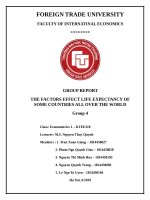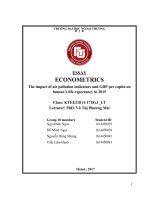tiểu luận kinh tế lượng THE FACTORS EFFECT LIFE EXPECTANCY OF SOME COUNTRIES ALL OVER THE WORLD
Bạn đang xem bản rút gọn của tài liệu. Xem và tải ngay bản đầy đủ của tài liệu tại đây (345.05 KB, 34 trang )
FOREIGN TRADE UNIVERSITY
FACULTY OF INTERNATINAL ECONOMICS
********
GROUP REPORT
THE FACTORS EFFECT LIFE EXPECTANCY OF
SOME COUNTRIES ALL OVER THE WORLD
Group 4
Class: Econometrics 1 – KTEE218
Lecturer: M.S. Nguyen Thuy Quynh
Members : 1. Tran Xuan Giang – 1814450027
2. Pham Ngo Quynh Giao – 1814450028
3. Nguyen Thi Minh Hoa – 1814450193
4. Nguyen Quynh Trang – 1814450069
5. Le Ngo To Uyen – 1814450104
Ha Noi, 9/2019
ABSTRACT .............................................................................................
INTRODUCTION ...................................................................................
4
5
SECTION I: OVERVIEW OF THE TOPIC .......................................
6
1. Definition ...........................................................................................................
6
1.1 Life expectancy ............................................................................................
6
1.2 Current health expenditure per capita .......................................................
6
1.3 Physician .....................................................................................................
6
1.4 Alcohol consumption per capita .................................................................
6
1.5 Lower secondary completion rate ...............................................................
7
2. Economic theories ..................................................................................................
7
3. Literature review ...................................................................................................
9
4. Research hypotheses ............................................................................................ 11
SECTION II: MODEL SPECIFICATION ........................................ 11
1.
Methodology .................................................................................................... 11
2.
Theoretical model specification ..................................................................... 12
3.
Describe the data ............................................................................................ 12
3.1
Specify the source of data ......................................................................... 12
3.2
Descriptive Statistics and interpretation for each variable ..................... 13
3.3
Correlation matrix between variables ...................................................... 15
SECTION III: HYPOTHESIS ............................................................. 16
1.
Estimated model ............................................................................................. 16
1.1
Estimation results...................................................................................... 16
2.
1.2
Sample regression model......................................................................... 17
1.3
The coefficient of determination............................................................. 17
1.4
Explain the meanings of estimated coefficient........................................ 17
Hypothesis testing.......................................................................................... 18
2.1
Test an individual regression coefficient................................................. 18
2.2
Testing the overall significance............................................................... 21
3. Recommendations.............................................................................................. 22
CONCLUSION......................................................................................24
INDIVIDUAL ASSESSMENT............................................................. 25
REFERENCES......................................................................................26
APPENDIX............................................................................................ 27
ABSTRACT
Our research has been conducted with a view to examining the relationship
between each of the four factors affecting the life expectancy and life expectancy. First
of all, the research relates four elements which have the impacts on the life expectancy
are Current health expenditure per capita, Physician, Alcohol consumption per capita
and Lower secondary completion rate. Besides, the multiple regression analysis was
conducted with the data of some countries all over the world collected from World
Bank database. Regression specification error test (RESET) was also conducted to
ensure that the regression model specified is adequate. After that, the findings have
shown there are positive relationship between life expectancy and current health
expenditure per capita, Physician and Lower secondary completion rate, whereas,
Alcohol consumption per capita and life expectancy have a negative relationship.
Therefore, we can have a better awareness of the factors which can have good or bad
effects on our life expectancy. If we spend more on our health expenditure or have the
higher secondary education rate and physicians in a country, we can expand our life
expectancy. In the contrast, our life expectancy can suffer severe impacts if we
consume alcohol too much.
INTRODUCTION
In the today’s world, life expectancy is one of the significant problems that can
draw attention to all the world’s citizens. Life expectancy is also one of the best
measures to evaluate health status of nations. The life expectancy for each individual or
group can be affected by several variables such as gender, genetics, lifestyle, access to
healthcare, economic status, the relevant mortality and morbidity and so on. However,
we have not had an exact answer for the question “How long a person can live?” yet.
Despite the fact that we could not calculate the accurate one person’s life span, there
was still a lot of researches in the recent decades which have shown that some factors
can affect the life expectancy more than the others are Current health expenditure per
capita, Physician, Alcohol consumption per capita and Lower secondary completion
rate.
Having the awareness of how important the life expectancy is, we decided to find
more about elements affect the life span whether it is a good or bad factor. With the
tools of econometrics, especially STATA, we set a model with five variables included
dependent variable, which is the life expectancy (LE) and independent variables, which
are current health expenditure per capita (HEC), physician, alcohol consumption per
capita and lower secondary completion rate to optimize analysis process.
This research could be used as a guideline and may be significant for future
researchers and policy makers who aim to improve the life expectancy in each country
all over the world. Though having tried our best, there are still unavoidable mistakes in
every stage of this study. Therefore, please let us know and feel free to discuss if you
have any concern.
SECTION I: OVERVIEW OF THE TOPIC
1. Definition
1.1 Life expectancy
Life expectancy, often abbreviated to LEB (for Life expectancy at birth), is a
statistical measure of the average time an organism is expected to live, based on the
year of its birth, its current age and other demographic factors including gender.
1.2 Current health expenditure per capita
Health spending measures the final consumption of health care goods and
services including personal health care (curative care, rehabilitative care, long-term
care, ancillary services and medical goods) and collective services (prevention and
public health services as well as health administration), but excluding spending on
investments.
1.3 Physician
A physician, medical practitioner, medical doctor, or simply doctor, is a
professional who practices medicine, which is concerned with promoting,
maintaining, or restoring through the study, diagnosis, prognosis and treatment of
disease, injury and other physical and mental impairments.
1.4 Alcohol consumption per capita
Alcohol consumption per capita is annual consumption of pure alcohol in liters
per person. In addition, recorded alcohol per capita consumption of pure alcohol
is calculated as the sum of beverage specific alcohol consumption of pure alcohol
(beer, wine, spirits, other) from different sources.
1.5 Lower secondary completion rate
Secondary completion rate is the total number of graduates from the last grade of
secondary education, regardless of age, expressed as a percentage of the population of
the age group that officially corresponds to that of graduating from secondary schools.
About the lower secondary education completion rate, it is measured as the gross
intake ratio to the last grade of lower secondary education (general and pre-vocational).
It is calculated as the number of new entrants in the last grade of lower secondary
education, regardless of age, divided by the population at the entrance age for the last
grade of lower secondary education.
2. Economic theories
Life expectancy is an important research topic that has drawn a lot of attention of
scholars in the past decades. Therefore, it could be useful to start out by examining
how factors was addressed in previous researches.
Health care systems is a problem in each country even it is a developed country
or not. Many previous studies have used child mortality and mortality rate indicator as
a proxy for health. Anyanwu and Erhijakpor (2007) found that health expenditure had a
significant effect on infant mortality and there was less than five mortality in 47
selected African countries between 1999 and 2004. In contrast, some studies that
analyzed health expenditure did not find any impact on health indicators after adjusting
other factors; for instance, Musgrove et al. (2005) found that the total spending on
health did not affect gjhs.ccsenet.org Global Journal of Health Science Vol. 9, No. 5;
2017 108 the mortality rates. In contrast, the present study utilized life expectancy as
an indicator of health outcomes. Increased one unit of per person Health Expenditure
Per Capita (HEC) will increase the life expectancy in an average of 8 days in a year.
The increased total expenditure on health as a percentage of gross domestic products
will improve expected years of by 8 days. It shows that an increase in Health
expenditure per capita has relevance to an increase in life expectancy.
On the other hand, a country’s drinking habits affect its population’s life
expectancy. By scraping the World Health Organization’s (WHO) Substance Abuse
Country Profiles, we found each nation’s annual consumption of alcohol per capita.
The correlation between life expectancy and alcohol consumption doesn’t seem to be a
positive one. Drinking wine in moderation may be beneficial for some people’s heart
health but stopping at just one glass isn’t always as easy as it seems. The reality about
alcohol consumption is that the developed countries are drinking less and, in contrast,
consumption in developing countries is increasing. Most developing countries do not
have a national policy to reduce alcohol consumption. Alcohol consumption
exacerbates poverty then affect life expectancy. Drinking costs a nation billions of
dollars. While the hidden cost has not been calculated for many countries, the burden
on any nation is bound to be substantial when the cost of medical care, lost
productivity through absenteeism, accidents at work, loss of job skills, salaries for
police and social workers, court costs, damage to property and cars, insurance
payments and so on are added together.
Interestingly, not all countries who drank below the average liters of alcohol
experienced higher life expectancies, which may point to other contributing factors for
lower life expectancies. But it can be easily understood that a rise in alcohol
consumption could decrease the life expectancy.
Life expectancy grows when there are more primary care physicians in the field.
According to a study led by researchers at Stanford and Harvard, it shows us just how
important primary care physicians are in prolonging our lives. Every 10 additional
primary care physicians per 100,000 people in the United States was associated with a
51.5-day increase in life expectancy during the decade from 2005 to 2015. “Greater
primary care physician supply was associated with improved population mortality,
suggesting that observed decreases in PCP supply may have important consequences
for population health,” the study said.
When countries develop economically, people live longer lives. Development
experts have long believed this is because having more money expands lifespan, but a
massive new study suggests that education may play a bigger role. The finding has
huge implications for public health spending. Schooling develops basic cognitive
functioning, such as reading, writing, and communicating, and teaches individuals how
to think logically, critically analyze data, solve problems, and implement plans. Higher
education is the key to stable and well-paid jobs, and increased income helps to pay for
nutritious food, better-quality housing, and high-quality medical care. In addition,
education promotes healthy lifestyles through the development of effective human
agency. Highly educated people use their knowledge, information, and past
experiences to avoid health-related risk factors and engage in health-enhancing
behaviors, such as smoking cessation, alcohol abstinence, and frequent physical
exercise. Moreover, education provides socio-psychological resources that can
contribute to health and longevity through emotional and instrumental support. That
well-educated people are more likely to be and remain married also contributes to the
relationship between education and health.
3. Literature review
Life expectancy is an important index that reflects the standard of living and the
social situation as well as the economic development level of a country. Therefore, in
recent decades, there are a lot of studies carried out that research about life expectancy
and the potential factors affecting it.
According to an article released by the Lancet on April 14, 2018 about “Risk
thresholds for alcohol consumption”, it has shown that the association between alcohol
consumption and total cardiovascular disease risk.
According to research from the National Institute on Alcohol Abuse and
Alcoholism, women are especially vulnerable to the negative medical effects of
excessive alcohol use.
Besides the alcohol consumption, there is an irrefutable positive correlation
between education and longevity. A study by the Washington University School of
Medicine suggests there are both direct and indirect health benefits of education. The
direct benefits include adopting healthier lifestyles, an increased ability to cope with
stress, and more effective management of chronic diseases. In terms of indirect
benefits, scientists point to a, generally, better social position, a bette r paying job, and
access to better medical care.
Another research was published on The Journal of Medical Research and
Innovation has shown an association of total Health Expenditure with GDP and life
expectancy.
According to Asian Economic and Financial Review “DETERMINANTS OF
LIFE EXPECTANCY: A PANEL DATA APPROACH”, Yavari and Mehrnoosh (2006)
analyzed the effects of socio- economic factors on life expectancy using multiple
regression analysis. This study showed that there is a positive, strong correlation
between life expectancy as an independent variable and per capita income, health
expenditures, literacy rate and daily calorie intake. Also, it revealed that there is a
negative strong correlation between life expectancy and the number of people per
doctor in African countries.
A study led by researchers at the Stanford University School of Medicine and
Harvard Medical School published Feb. 18 in JAMA Internal Medicine has shown that
Greater primary care physician supply was associated with lower mortality.
From the review of literature, we can see that alcohol consumption, health
expenditure, education and the number of physicians, all of them are the factors that
have effect on people’s life expectancy. However, there is no current study including
impact of all these factors, so we decided to conduct this research to find out how they
affect on the life expectancy of 136 countries all over the world.
4. Research hypotheses
In this research, we expected that there is a positive relationship between health
expenditure, lower secondary education completion rate, the number of physician and
life expectancy. If we increase our health expenditure or have the higher secondary
education rate or have more physicians in a country, we can expand our life
expectancy.
We also predicted that the total alcohol consumption would have negative effect
on people’s life span. The result of the study is supposed to prove that our life
expectancy can suffer severe impacts if we increase our alcohol consumption too
much.
SECTION II: MODEL SPECIFICATION
1. Methodology
Thank for using the multiple regression analysis that shall be conducted in order
to observe what relationship each variable has with life expectancy. STATA shall be
used for analysis.
The model also use the Ordinary Least Squares Regression to estimate the
relationship between 4 independent variables and a dependent variable; the method
estimates the relationship by minimizing the sum of the squares in the difference
between the observed and predicted value of the dependent variables configured as a
straight line.
2. Theoretical model specification
PRF: LE=
1+ 2*HEC+
3*physician+
4*alcohol+
5*secondary+ui
Whereas:
•
LE: Life expectancy at birth, total (years)
•
HEC: Current health expenditure per capita, PPP (current international $)
•
physician: Physicians (per 1000 people)
•
alcohol: Total alcohol consumption per capita (liters of pure alcohol,
projected estimates, 15+ years of age)
•
secondary: Lower secondary completion rate, total (% of relevant age
group)
•
ui: The disturbance of observation i, represents other factors that affect
consumption.
➢
Dependent variable is LE.
➢
Independent variables are HEC, physician, alcohol, secondary. Basing on the theoretical above,
the total alcohol consumption per capita has negative relationship with life expectancy. On the other
hand, the current health expenditure per capita, physicians (per 1000) and lower secondary
completion rate have positive one with life expectancy.
3. Describe the data
3.1 Specify the source of data
Based on data of current health expenditure per capita, physicians, total alcohol
consumption per capita, lower secondary completion rate drawn from World Bank
databank, multiple regression analysis shall be conducted in order to observe what
relationship each variable has with life expectancy. The data range in the year 2016 of
some countries over the world.
3.2 Descriptive Statistics and interpretation for each variable
Based on what has been observed above, each of 4 factors has an association with
life expectancy, each one at a different level. This research shall draw on some
countries around the world, collected from World Bank databank and observe a
relationship between each factor and life expectancy. Four specific variables employed
here are current health expenditure per Capita, PPP (current international $); Physicians
(per 1000), total alcohol consumption per capita (liters of pure alcohol, projected
estimates, 15+ years of age), Lower secondary completion rate, total (% of relevant age
group)
The data is for 136 countries, which are countries with enough data for all five
variables.
Variable
Shorten
title
Mean
median
Standard
deviation
Max
Min
Life
expectancy
LE
73.04522
74.65537
7.533
84.22683
51.593
HEC
1549.943
934.0632
1784.483
9869.742
29.90777
Physician
1.789
1.535
1.471
5.399
0.0157
Alcohol
6.511
6.8
4.286
15.2
0
Secondary
52.043
86.945
27.400
156.934
10.025
Current
health
expenditure
per capita
Physicians
Total
alcohol
consumption
Lower
secondary
completion
rate
1. Life expectancy
The number of years that a person can expect live. The life expectancy is based
on the year of its birth, its current and other factors including gender. It reflects the
overall mortality level of a population and summarizes the mortality pattern that
prevails across all age groups in a given year. It is calculated in a period life table
which provides a snapshot of a population’s mortality pattern at a given time. In our
model, we take the data about life expectancy in 2015 of some high-income
countries.
2. Current health expenditure per capita, PPP (current international $)
Data used in this report consists of current health expenditures, which are both of
healthcare goods and services consumed during each year. They include health
services (preventive and curative), family planning activities, nutrition activities, and
emergency aid designated for health but does not include provision of water and
sanitation. Data are in current U.S. dollars. The health expenditure estimates have
been prepared by the World Health Organization under the framework of the System
of Health Accounts 2011 (SHA 2011).
3. Physicians (per 1000 people)
Physicians include generalist and specialist medical practitioners. Health system
data includes physicians are increasingly being recognized as key to combating
disease and improving the health status of populations. The data is estimated number
of physicians per 1,000 people. The WHO compiles data from household and labor
force surveys, censuses, and administrative records.
4. Total alcohol consumption per capita
This indicator measures the sum of both recorded and unrecorded adult per
capita consumption (15 years of age or older) over a calendar year, in litres of pure
alcohol, adjusted for tourist consumption. Data on recorded alcohol per capita
consumption of adults (15+ years) are for 2016 and were obtained from the WHO
Global Information System on Alcohol and Health. Recorded alcohol per capita
consumption of adults reflects the consumption of pure alcohol per person per
country in a given year, and is computed from government records (taxation),
industry publications for the production and sales of alcohol as well as data from the
UN Food and Agricultural Organization.
5. Lower secondary completion rate, total (% of relevant age group)
This rate is measured as the percentage of pupils who completed the last year of
lower secondary schooling, regardless of age. It is calculated as the number of new
entrants in the last grade of lower secondary education divided by the total number
of children of official completing age. Country-specific definition, method and
targets are determined by countries themselves. Data were collected from national
and other publicly available sources and validated by the Local Education Group
(LEG) in each country.
3.3 Correlation matrix between variables
LE
HEC
physician
alcohol
Secondary
1.0000
HEC
0.6658
1.0000
physician
0.7040
0.6844
1.0000
alcohol
0.3259
0.4410
0.5774
1.0000
secondary
0.6918
0.5364
0.5994
0.32141
1.0000
SECTION III: HYPOTHESIS
1. Estimated model
1.1 Estimation results
➢
Linear Regression model
OLS results – Linear Regression Model
Observations 1-136
Dependent variable: LE
Coefficient
Std. Error
t-ratio
p-value
Const
61.41307
1.303709
47.11
0.000
HEC
0.0011434
0.0003062
3.73
0.000
Physician
1.914654
0.4280533
4.47
0.000
Alcohol
-0.2216016
0.1112142
-1.99
0.048
Secondary
0.0997977
0.018121
5.51
0.000
Mean
dependent var
73.04522
S.D. dependent var
56.7573
Sum squared
resid
2654.75358
S.E. of regression
4.5017
R-squared
0.6535
Adjusted R-squared
0.6429
F(4,131)
61.77
P-value(F)
0.0000
̂̂
=61.41307+0.0011434*HEC+1.914654*physician-0.2216016*alcohol+0.0997977*secondary
1.2 Sample regression model
LE=61.41307+0.0011434*HEC+1.914654*physician-0.2216016*alcohol+0.0997977*secondary+ ̂
1.3 The coefficient of determination
The coefficient of determination measures the goodness of fit
2
∑
=1
=
=1−
=1−
2
2
∑
=1
2
R measures the proportion of the total variation in LE explained by the
regression model.
2
R =0.6535: 65.35% of the total variation in LE is explained by the regression
model and the remains is due to other factors.
1.4 Explain the meanings of estimated coefficient
➢
The interpretation of the intercept term in the regression equation: If the
independent variables equal 0 then the expected mean value of the dependent
variable is the intercept.
It means: If HEC=0
physician =0
alcohol=0
secondary=0
→ LE=61.41307
➢
The interpretation of the slope terms in the regression equation:
▪
HEC=0.0011434: If current health expenditure per capita increases by 1 dollar→
Life expectancy will rises 0.0011434 year given other factors in the model are
constant.
▪
= 1.914654: If physicians (per 1000) increases by 1 doctors → Life
expectancy will rises for 1.914654years given other factors in the model are constant.
▪
physician
alcohol =
-0.2216016: If total alcohol consumption per capita increases by 1 liters
→ Life expectancy will fall for -0.2216016 year given other factors in the model are
constant.
▪
secondary
= 0.0997977: If lower secondary completion rate increases by 1%→
Life expectancy will rise for 0.0997977 year given other factors in the model are
constant.
2. Hypothesis testing
2.1 Test an individual regression coefficient
There are 3 methods to test hypothesis:
+ Method 1: Confidence interval approach
+ Method 2: Test of significant
+ Method 3: P – value approach
a.
βHEC
{
0:
1:
=0
≠0
➢
Method 1: Confidence interval approach
Based on STATA table the confidence interval of = [0.00054; 0.00175]
βHEC=0 doesn’t belong to [0.00054; 0.00175]→ reject
̂
➢
Method 2:Test of significant
0
→βHECis significant.
̂̂
−
t s=
0.00114−0
=
̂̂
(
=3.73
)
0.0003
t = − = 136−5= 131 = 1.96
c
0.05⁄2 0.025
⁄2
|>tc→ reject Ho
we see that |
➢
Method 3: P – value approach
p- value of HEC =0.000<0.05→ reject Ho
→ the current health expenditure per capita has effect on life expectancy, for a
significance level of 5%
βphysician
b.
{
0
:
ℎ
=0
➢
Method 1: Confidence interval approach
Based on STATA table the confidence interval of
βphysician=0 doesn’t belong to [1.0678; 2.7614]→ reject 0 →βphysician is significant.
➢
Method 2:Test of significant
−
̂̂
ℎ
ℎ
t s=
1.9147−0
=
̂̂
(
)
t = − = 136−5= 131 = 1.96
we see that |
c
⁄2
= 4.47
0.4281
ℎ
0.05⁄2 0.025
|>tc→ reject Ho
ℎ
̂
= [1.0678; 2.7614]
➢
Method 3: P – value approach
p- value of physician =0.000<0.05→ reject Ho
→ the Physicians (per 1000 people) has effect on life expectancy, for a
significance level of 5%
c.
alcohol
{
➢
➢
ℎ
=0
(
ℎ
̂)
ℎ
=
0.1112
̂
= [-0.4416; -0.0016] βalcohol=0 doesn’t belong to [-0.4416; -0.0016]→ reject 0
−0.2216−0
= -1.99
t = − = 136−5= 131 = 1.96
we see that |
ℎ
Method 2:Test of significant
−
̂
ℎ
➢
:
Method 1: Confidence interval approach
Based on STATA table the confidence interval of
→βalcohol is significant.
ts=
0
c
⁄2
0.05⁄2 0.025
|>tc→ reject Ho
Method 3: P – value approach
p- value of alcohol=0.048<0.05→ reject Ho
→ thealcohol consumption has effect on life expectancy, for a significance level
of 5%
d.
secondary
{
0:
=0
➢
Method 1: Confidence interval approach
̂
Based on STATA table the confidence interval of
βsecondary=0 doesn’t belong to [0.0639;0.1356]→ reject
= [0.0639;0.1356]
0
→βsecondary is significant.
➢ 0 .0997 Method
2:Test of significant
−0
ts=
0
.0181
= 5.51
t = − = 136−5= 131 = 1.96
➢
c
⁄2
0.05⁄2 0.025
|>tc→ reject Ho
we see that |
Method 3: P – value approach
p- value of secondary=0.000<0.05→ reject Ho
→ thelower secondary education has effect on life expectancy, for a significance
level of 5%
2.2 Testing the overall significance
There are 2 methods to test hypothesis:
+ Method 1: Confidence interval approach
+ Method 1: Test of significant F-test
+
Method 2: P – value approach
2
: coefficient of determination
➢
F0= 21−
2
{ 0:2 =0
1: ≠0
Method 1:Test of significant F-test
( −5)
2
= 61.77
F5%, (4, 131) =2.445
→
➢
Fs > F5%, (4, 131)→ Reject H0
F0= 21−
Method 2: P – value approach
( −2)
2
= 61.77
p- value = P (F > F0) = 0.0000
→
p-value < 0.05 → Reject H0
The model statistically is fitted. Because variables are not significant at the
5% level and only 1 variable is significant at the 5% level.
3. Recommendations
According to the findings of the study, we can enhancing health outcomes
through improved educational attainment, lower alcohol consumption, more healthcare
expenditure and increased primary care physicians.
Governments of countries should establish a national program that forgives the
student-loan debt of any newly trained doctor who agrees to two or three years of
primary-care service in underserved areas. The cost to the government would be offset
long-term by improved community health and reduced hospitalizations.
They also have to reduce the affordability, availability and promotion of alcohol
to improve national life expectancy. A minimum unit price for alcohol is one of the
best ways to reduce drinking in the heaviest drinkers and tackle the alcohol related
health inequalities.
Governments should subsidy of secondary education and encourage the spend of
citizen for health care services.
CONCLUSION
In brief, life expectancy has been one of the most significant issues worldwide. In
our report, even though there is a model that has statistically significant and possibly
economically significant independent variables, we have to emphasize that the
variables chosen are probably not the best measures of the life expectancy because life
expectancy can be influenced by many other factors such as gender, genetics, lifestyle
and so on. This is the biggest drawback that we could not avoid. Besides, data
collecting is manual from different sources in the Internet so that mistakes could not be
avoided, this is also a limitation.
On the other hand, we have some recommendations concluded from the model. If
possible, we should add more other variables such as gender, genetics, marital status
and so on to this model in order to have a better overview about the research.
INDIVIDUAL ASSESSMENT
Minh Hoa
Quynh Trang
To Uyen
Quynh Giao
Xuan Giang
Minh Hoa
10
10
10
10
10
Quynh Trang
10
10
10
10
10
To Uyen
10
10
10
10
10
Quynh Giao
10
10
10
10
10
Xuan Giang
10
10
10
10
10
Average score
10
10
10
10
10
Evaluator


